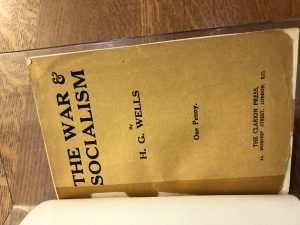War and Socialism in H.G. Wells by Andrew R.
A quick summary of a ‘Dream of Armageddon’, published in 1901, is as follows:
The narrator has a conversation with a man who describes his dreams in vivid detail, going as far as to say that his dreams are his actual life. In his dream, he describes Capri and his love and describes how a great war came over the land, using new technology that is eerily accurate to the actual weapons in the future, and how he and his love were killed.
The first aspect of this object that strikes me is its size. It is small and has an almost pamphlet-like quality. Immediately, the size changes the way I see the manner in which “A Dream of Armageddon” would be read and subsequently, the target audience of H.G. Wells’ short stories. The small size and leaflet quality as well as the cheap cost, only 1 penny, indicates that these stories were supposed to be read quickly and by all audiences, rather than just the wealthy and educated elite.
Therefore, another aspect is shown: the potential relationship between socialism and science fiction. The content of this essay regarding socialism, including its title “The War and Socialism”, demonstrate Wells’ support for socialism and his opposition warfare, especially private benefit from warfare. As a result, the meaning of “A Dream of Armageddon” transforms from a vague and outlandish dream to a targeted and creative criticism of the capitalist system that would be leading into a war as it was described. Wells’ is shown to use the genre of science fiction to weave warnings of the capitalist future unless the system of socialism was adopted to prevent the horrors of capitalism, like war for private benefit, from becoming actualized. The similarities between his criticism in both fiction and nonfiction are striking and make it Wells’ opposition to capitalism and war well know, not through content but through tone and condemnation of capitalism and war. In his fiction, his narrative demonstrated the consequences of capitalistic war through the experiences of the characters, in the case of a dream of armageddon, through the death experienced through the dream. Even though Wells did not directly describe a socialist system that would replace the jingoistic one he describes, the criticism of the war was substantially developed to the point where his preference for socialism crystallized by the end of the text. However, his nonfiction was more of a condemnation of the system holistically rather than an acute view into the potential ramifications of war on a micro-scale. Read together, the works furthered my understanding of Wells’ socialist political views. While reading solely ‘A Dream of Armageddon’ demonstrated that Wells’ may have preferred socialism, reading “The War & Socialism” allowed me to connect his nonfiction with his fiction, making his critique much more salient and effective.
Moreover, the significance of the form of the story in a leaflet and at a low cost is that it allowed for Wells’ stories to reach those who would most identify with his message: the low wage workers, the soldiers, and the common folk. These audiences would be more receptive to the themes of socialism and critiques of capitalism that are developed throughout his stairs and thus increase awareness and support for the issues that Wells’ attempts to address. Additionally, reading this essay in this form is much more powerful than it would be online, as the size and physical appearance of the text are immensely influential in developing the understanding of the target audience and tone of HG Wells.











Recent Comments